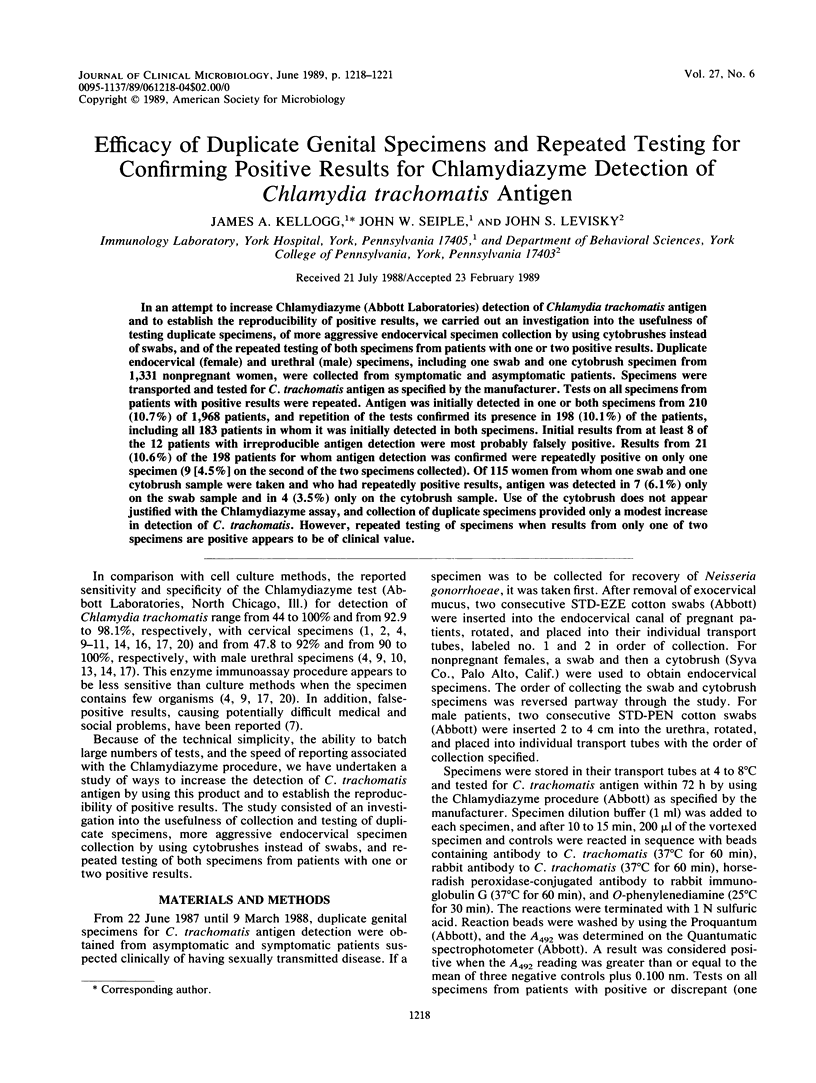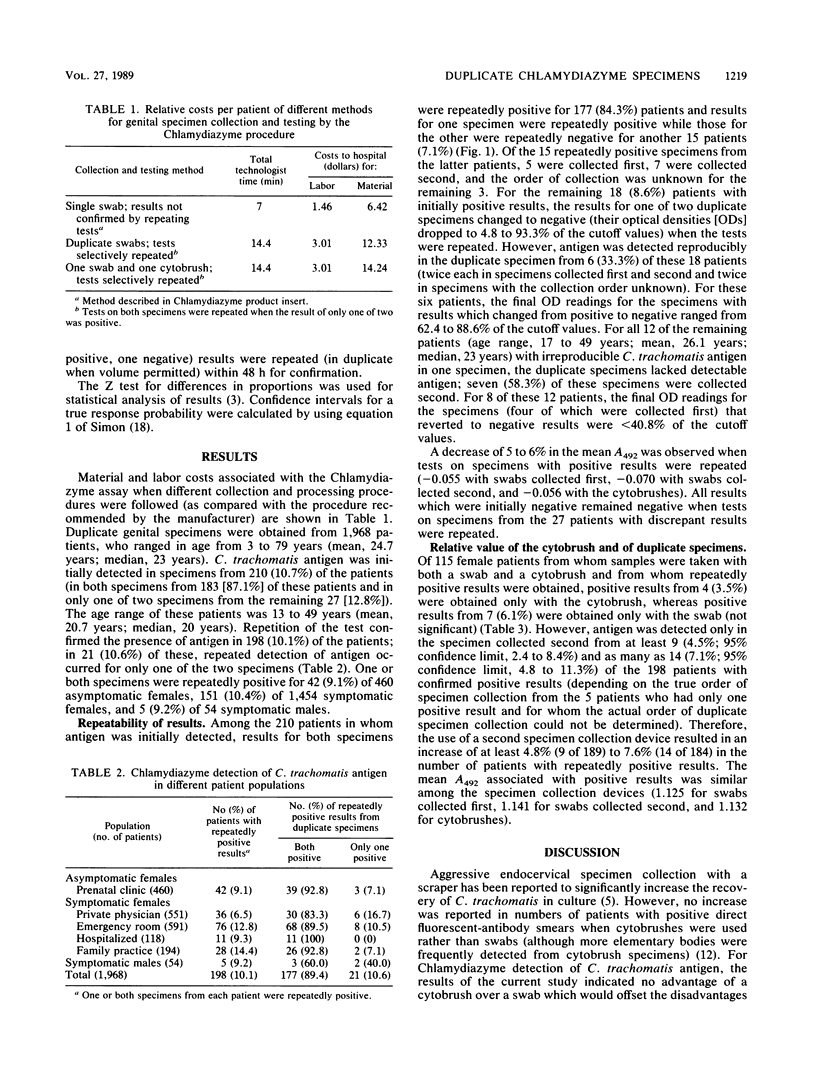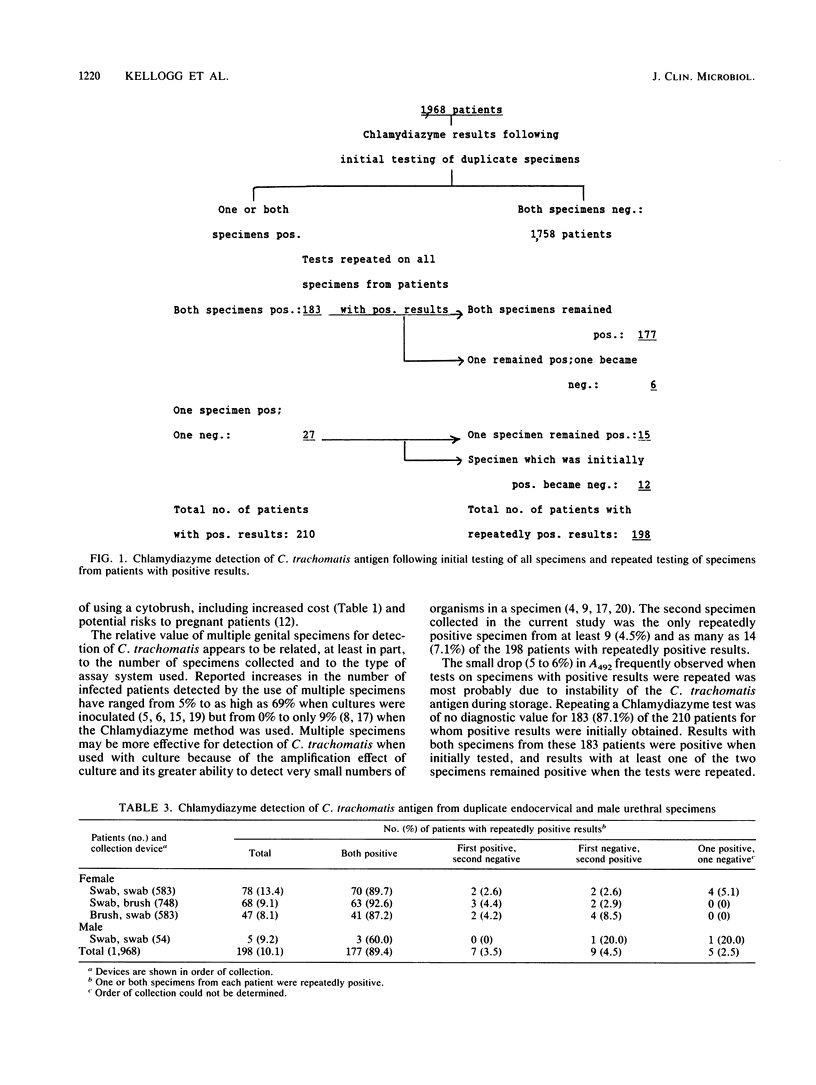Abstract
In an attempt to increase Chlamydiazyme (Abbott Laboratories) detection of Chlamydia trachomatis antigen and to establish the reproducibility of positive results, we carried out an investigation into the usefulness of testing duplicate specimens, of more aggressive endocervical specimen collection by using cytobrushes instead of swabs, and of the repeated testing of both specimens from patients with one or two positive results. Duplicate endocervical (female) and urethral (male) specimens, including one swab and one cytobrush specimen from 1,331 nonpregnant women, were collected from symptomatic and asymptomatic patients. Specimens were transported and tested for C. trachomatis antigen as specified by the manufacturer. Tests on all specimens from patients with positive results were repeated. Antigen was initially detected in one or both specimens from 210 (10.7%) of 1,968 patients, and repetition of the tests confirmed its presence in 198 (10.1%) of the patients, including all 183 patients in whom it was initially detected in both specimens. Initial results from at least 8 of the 12 patients with irreproducible antigen detection were most probably falsely positive. Results from 21 (10.6%) of the 198 patients for whom antigen detection was confirmed were repeatedly positive on only one specimen (9 [4.5%] on the second of the two specimens collected). Of 115 women from whom one swab and one cytobrush sample were taken and who had repeatedly positive results, antigen was detected in 7 (6.1%) only on the swab sample and in 4 (3.5%) only on the cytobrush sample. Use of the cytobrush does not appear justified with the Chlamydiazyme assay, and collection of duplicate specimens provided only a modest increase in detection of C. trachomatis. However, repeated testing of specimens when results from only one of two specimens are positive appears to be of clinical value.
Full text
PDF



Selected References
These references are in PubMed. This may not be the complete list of references from this article.
- Amortegui A. J., Meyer M. P. Enzyme immunoassay for detection of Chlamydia trachomatis from the cervix. Obstet Gynecol. 1985 Apr;65(4):523–526. [PubMed] [Google Scholar]
- Baselski V. S., McNeeley S. G., Ryan G., Robison M. A comparison of nonculture-dependent methods for detection of Chlamydia trachomatis infections in pregnant women. Obstet Gynecol. 1987 Jul;70(1):47–52. [PubMed] [Google Scholar]
- Chernesky M. A., Mahony J. B., Castriciano S., Mores M., Stewart I. O., Landis S. J., Seidelman W., Sargeant E. J., Leman C. Detection of Chlamydia trachomatis antigens by enzyme immunoassay and immunofluorescence in genital specimens from symptomatic and asymptomatic men and women. J Infect Dis. 1986 Jul;154(1):141–148. doi: 10.1093/infdis/154.1.141. [DOI] [PubMed] [Google Scholar]
- Dunlop E. M., Goh B. T., Darougar S., Woodland R. Triple-culture tests for diagnosis of chlamydial infection of the female genital tract. Sex Transm Dis. 1985 Apr-Jun;12(2):68–71. doi: 10.1097/00007435-198504000-00003. [DOI] [PubMed] [Google Scholar]
- Embil J. A., Thiébaux H. J., Manuel F. R., Pereira L. H., MacDonald S. W. Sequential cervical specimens and the isolation of Chlamydia trachomatis: factors affecting detection. Sex Transm Dis. 1983 Apr-Jun;10(2):62–66. doi: 10.1097/00007435-198304000-00003. [DOI] [PubMed] [Google Scholar]
- Hammerschlag M. R., Rettig P. J., Shields M. E. False positive results with the use of chlamydial antigen detection tests in the evaluation of suspected sexual abuse in children. Pediatr Infect Dis J. 1988 Jan;7(1):11–14. doi: 10.1097/00006454-198801000-00004. [DOI] [PubMed] [Google Scholar]
- Hernandez T. J., Noller K. L., Smith T. F. Detection of Chlamydia trachomatis using consecutive endocervical swabs. Prevalence in asymptomatic female adolescents and women attending a sexually transmitted disease clinic. J Reprod Med. 1986 Jun;31(6):497–500. [PubMed] [Google Scholar]
- Hipp S. S., Han Y., Murphy D. Assessment of enzyme immunoassay and immunofluorescence tests for detection of Chlamydia trachomatis. J Clin Microbiol. 1987 Oct;25(10):1938–1943. doi: 10.1128/jcm.25.10.1938-1943.1987. [DOI] [PMC free article] [PubMed] [Google Scholar]
- Howard L. V., Coleman P. F., England B. J., Herrmann J. E. Evaluation of chlamydiazyme for the detection of genital infections caused by Chlamydia trachomatis. J Clin Microbiol. 1986 Feb;23(2):329–332. doi: 10.1128/jcm.23.2.329-332.1986. [DOI] [PMC free article] [PubMed] [Google Scholar]
- Lefebvre J., Laperrière H., Rousseau H., Massé R. Comparison of three techniques for detection of Chlamydia trachomatis in endocervical specimens from asymptomatic women. J Clin Microbiol. 1988 Apr;26(4):726–731. doi: 10.1128/jcm.26.4.726-731.1988. [DOI] [PMC free article] [PubMed] [Google Scholar]
- Lindner L. E., Nettum J. A., Miller S. L., Altman K. H. Comparison of scrape, swab, and cytobrush samples for the diagnosis of cervical chlamydial infection by immunofluorescence. Diagn Microbiol Infect Dis. 1987 Nov;8(3):179–182. doi: 10.1016/0732-8893(87)90169-6. [DOI] [PubMed] [Google Scholar]
- Moi H., Danielsson D. Diagnosis of genital Chlamydia trachomatis infection in males by cell culture and antigen detection test. Eur J Clin Microbiol. 1986 Oct;5(5):563–568. doi: 10.1007/BF02017706. [DOI] [PubMed] [Google Scholar]
- Mumtaz G., Mellars B. J., Ridgway G. L., Oriel J. D. Enzyme immunoassay for the detection of Chlamydia trachomatis antigen in urethral and endocervical swabs. J Clin Pathol. 1985 Jul;38(7):740–742. doi: 10.1136/jcp.38.7.740. [DOI] [PMC free article] [PubMed] [Google Scholar]
- Munday P. E., Carder J. M., Hanna N. F., Taylor-Robinson D. Is one swab enough to detect chlamydial infection of the cervix? Br J Vener Dis. 1984 Dec;60(6):384–386. doi: 10.1136/sti.60.6.384. [DOI] [PMC free article] [PubMed] [Google Scholar]
- Pao C. C., Lin S. S., Yang T. E., Soong Y. K., Lee P. S., Lin J. Y. Deoxyribonucleic acid hybridization analysis for the detection of urogenital Chlamydia trachomatis infections in women. Am J Obstet Gynecol. 1987 Jan;156(1):195–199. doi: 10.1016/0002-9378(87)90237-7. [DOI] [PubMed] [Google Scholar]
- Ryan R. W., Kwasnik I., Steingrimsson O., Gudmundsson J., Thorarinsson H., Tilton R. C. Rapid detection of Chlamydia trachomatis by an enzyme immunoassay method. Diagn Microbiol Infect Dis. 1986 Sep;5(3):225–234. doi: 10.1016/0732-8893(86)90006-4. [DOI] [PubMed] [Google Scholar]
- Simon R. Confidence intervals for reporting results of clinical trials. Ann Intern Med. 1986 Sep;105(3):429–435. doi: 10.7326/0003-4819-105-3-429. [DOI] [PubMed] [Google Scholar]
- Singal S. S., Reichman R. C., Graman P. S., Greisberger C., Trupei M. A., Menegus M. A. Isolation of Chlamydia trachomatis from men with urethritis: relative value of one vs. two swabs and influence of concomitant gonococcal infection. Sex Transm Dis. 1986 Jan-Mar;13(1):50–52. doi: 10.1097/00007435-198601000-00011. [DOI] [PubMed] [Google Scholar]
- Smith J. W., Rogers R. E., Katz B. P., Brickler J. F., Lineback P. L., Van der Pol B., Jones R. B. Diagnosis of chlamydial infection in women attending antenatal and gynecologic clinics. J Clin Microbiol. 1987 May;25(5):868–872. doi: 10.1128/jcm.25.5.868-872.1987. [DOI] [PMC free article] [PubMed] [Google Scholar]


